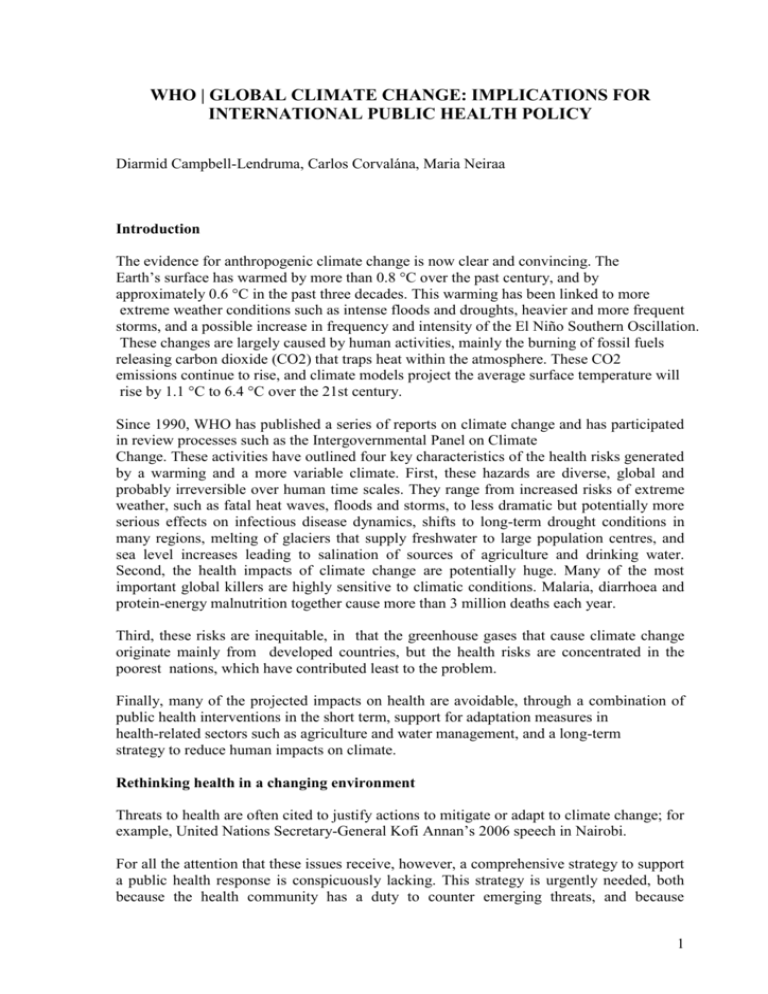
WHO | GLOBAL CLIMATE CHANGE: IMPLICATIONS FOR
INTERNATIONAL PUBLIC HEALTH POLICY
Diarmid Campbell-Lendruma, Carlos Corvalána, Maria Neiraa
Introduction
The evidence for anthropogenic climate change is now clear and convincing. The
Earth’s surface has warmed by more than 0.8 °C over the past century, and by
approximately 0.6 °C in the past three decades. This warming has been linked to more
extreme weather conditions such as intense floods and droughts, heavier and more frequent
storms, and a possible increase in frequency and intensity of the El Niño Southern Oscillation.
These changes are largely caused by human activities, mainly the burning of fossil fuels
releasing carbon dioxide (CO2) that traps heat within the atmosphere. These CO2
emissions continue to rise, and climate models project the average surface temperature will
rise by 1.1 °C to 6.4 °C over the 21st century.
Since 1990, WHO has published a series of reports on climate change and has participated
in review processes such as the Intergovernmental Panel on Climate
Change. These activities have outlined four key characteristics of the health risks generated
by a warming and a more variable climate. First, these hazards are diverse, global and
probably irreversible over human time scales. They range from increased risks of extreme
weather, such as fatal heat waves, floods and storms, to less dramatic but potentially more
serious effects on infectious disease dynamics, shifts to long-term drought conditions in
many regions, melting of glaciers that supply freshwater to large population centres, and
sea level increases leading to salination of sources of agriculture and drinking water.
Second, the health impacts of climate change are potentially huge. Many of the most
important global killers are highly sensitive to climatic conditions. Malaria, diarrhoea and
protein-energy malnutrition together cause more than 3 million deaths each year.
Third, these risks are inequitable, in that the greenhouse gases that cause climate change
originate mainly from developed countries, but the health risks are concentrated in the
poorest nations, which have contributed least to the problem.
Finally, many of the projected impacts on health are avoidable, through a combination of
public health interventions in the short term, support for adaptation measures in
health-related sectors such as agriculture and water management, and a long-term
strategy to reduce human impacts on climate.
Rethinking health in a changing environment
Threats to health are often cited to justify actions to mitigate or adapt to climate change; for
example, United Nations Secretary-General Kofi Annan’s 2006 speech in Nairobi.
For all the attention that these issues receive, however, a comprehensive strategy to support
a public health response is conspicuously lacking. This strategy is urgently needed, both
because the health community has a duty to counter emerging threats, and because
1
increased attention to climate change offers opportunities to focus on the most
disadvantaged populations’ current needs. For example, the international community has
agreed on the principle of a global climate change adaptation fund, funded by a 2% levy on
a multibillion-dollar Clean Development Mechanism.
However, this opportunity to strengthen public health can be seized only if the health sector
knows what it should do differently because of climate change. The development of a
comprehensive strategy will take time, but some essential principles are already clear. A
global problem requires a strategy of international dimensions that can translate into
regional and local actions. Just as climate change’s underlying causes are global, its health
implications do not respect national boundaries. Impacts in one location, such as infectious
disease epidemics or population displacements caused by droughts or rising sea levels,
quickly spread across national borders. Coordinated investments in preventive measures
therefore contribute to the “global public good” of reducing the risk of health emergencies.
The challenge is simplified somewhat by the fact that climate change is expected
to lead mainly to changes in existing health issues rather than to the emergence of new and
unfamiliar diseases. An important guiding principle therefore is to increase the priority
given to currently important health burdens that are likely to be worsened by climate
change. Such a “no regrets” strategy will bring important public health benefits under any
plausible future climate conditions. Adaptation to climate change is essentially a matter of
basic public health protection. The challenges of rapid environmental, demographic and
social changes all call for greater emphasis on disease prevention, providing a better
balance with the current focus on curative and reactive measures. The necessary
preventive actions to deal with most climate-sensitive diseases are already quite clear.
Climate change and other environmental stresses should help to refocus political and
financial commitments to implement these measures.
Preventive environmental health interventions
One emerging environmental health threat is the decline in global freshwater resources,
caused mainly by increasing rates of water extraction and contamination. Climate change is
expected to worsen this decline in water quality and quantity, particularly in already dry
regions such as the eastern Mediterranean and north Africa. Scaling up water and sanitation
services and providing point-of-use disinfection would reduce the current burden of disease
and ameliorate the health impacts of decreasing water supplies. Such interventions already
have a very high cost–benefit ratio; the threat of climate change makes these preventive
health measures an even wiser investment. As water stresses intensify, governments could
protect health by strengthening and enforcing their regulatory frameworks to ensure the
safe use of new water sources that will become increasingly important: wastewater, excreta
and greywater in agriculture and aquaculture. Infectious disease surveillance and response
Effective surveillance and response systems are essential in managing any infectious
disease, but they become even more important under conditions of rapid change. These
conditions include climatic shifts as well as increasing rates of movement of and contact
between humans, pathogens and reservoirs. These conditions all require improved human
health surveillance integrated with monitoring of climate and other environmental
conditions that favour disease outbreaks, including disease in wildlife and agricultural
animals. Climate change also strengthens the case for reinforcing response systems for
infectious disease outbreaks, including predefined action plans and maintenance of the
control resources and personnel capacity necessary to mount effective responses.
2
Environmental health in emergencies. The impacts of current and future natural disasters
could be reduced by the health sector defining integrated measures that address the root
causes of vulnerability, and planning for effective responses after such events. For
example, the health impacts of floods can be reduced by land management policies that
reduce deforestation and conserve the integrity of watersheds and coastal zones, minimize
the physical impacts of mudslides and storm surges, and decrease the chances of sewage
contamination. Post-flooding health effects can be reduced by adequately planned and
funded health-sector responses, including interventions to control outbreaks of vectorborne and water-related diseases.
Building capacity for health sector responses. Since 2000, WHO has worked with the
World Meteorological Organization and the UN Environment Programme to raise
awareness of climate change’s implications for the health sectors of highly vulnerable
regions. The necessary next step is to inform and support national health actors in taking
concrete actions to protect health. For example, WHO is addressing this need by initiating a
new project in 2006 on piloting approaches to protect health in changing climates.9 In
partnership with the UN Development Programme and with funding from the Global
Environmental Facility, this initiative is being implemented in seven vulnerable countries.
In each, the national health ministry chairs an intersectoral team that has identified priority
health risks from climate change given local environmental socioeconomic and health
contexts. Through the course of the initiative, this team will also identify, implement,
monitor and refine interventions to minimize health risks. The project will thereby support
targeted interventions in these countries, strengthen institutional capacity to address health
risks, involve an increasingly informed and engaged health sector in adapting to climate
change, and extract lessons that are applicable to other countries. It will also develop
monitoring mechanisms to ensure that resources are applied effectively in adaptation
projects within the health sector, and inform evaluations of support through this mechanism
as compared with more general health or development aid. This initiative is important
preparation for the wider action that will be necessary to meet the worldwide challenge of
adapting to health risks from climate change.
Strengthening alliances for sustainable development
The actions described above represent “safe investments” for climate change
adaptation funds within the health sector. However, many climatic risks to health lie at
least partly outside the health sector’s normal sphere of action. Perhaps most critically,
climate change has the capacity to suppress agricultural yields, with the greatest risks in
Africa, where malnutrition is already the largest single contributor to disease burdens.
Some of the most effective actions by health professionals may therefore involve
supporting other sectors’ efforts to mitigate and adapt to climate change. Much work still
needs to be done in this area, including: Protecting climate, improving health. Ultimately,
however, the public health community needs to go beyond reacting to a changing climate.
A true preventive strategy needs to ensure the maintenance and development of healthy
environments from local to global levels. In the long term, sustainable development and
protection of ecosystem services are fundamentally necessary for human health. This is not
just a case of protecting future generations, as even in the short term development choices
that protect the climate can benefit public health significantly. The intersection of energy,
transport, climate and health provides an example of this. The Stern Review of the
economics of climate change argues that the long-term benefits of major investments to cut
greenhouse gas emissions would vastly outweigh their costs, and that these are needed to
3
avoid potentially catastrophic impacts on the global economy. This coincides with a WHO
assessment that feasible improvements in environmental conditions could reduce the global
disease burden by more than 25%.14 Much of the current burden is due to unhealthy
energy and transport services. Changing these systems to reduce climate change could
therefore also bring significant and largely unacknowledged public health gains. Improving
access to public and active transport would greatly reduce CO2 emissions, while also
cutting the 800 000 annual global deaths from outdoor air pollution, the 1.2 million annual
deaths from traffic accidents, and the 1.9 million deaths from physical inactivity.11
Changing the poorest communities’ domestic energy technologies could reduce the 1.5
million annual indoor air pollution deaths.15 The critical next stage for the health
community is a more direct and assertive engagement with the environment and economic
sectors to ensure that health-supporting technological and development choices are
implemented.
Conclusions
Human-induced climate change is an emerging threat that rightly commands widespread
policy and public attention. Along with other rapid changes associated with global
population and economic growth, climate change strains existing weak points in health
protection systems and calls for reconsideration of public health priorities. The most
effective responses are likely to be strengthening of the key functions of environmental
management, surveillance and response to safeguard health from natural disasters and
changes in infectious disease patterns, and a more pro-active approach to ensure that
development decisions serve the ultimate goal of improving human health.16 For the most
part these are not new interventions but existing tools underutilized due to the “true
killers”: lack of political commitment and of financial resources. Climate change therefore
demands that we intensify our efforts in preventive public health and place that crucial task
at the core of sustainable development.
References
Surface temperature analysis: analysis graphs and plots. NASA: Goddard
Institute for Space Studies; 2007. Available from:
http://data.giss.nasa.gov/gistemp/graphs/
C Change. 2007: The physical science basis: summary for policymakers. Geneva:
Intergovernmental Panel on Climate Change secretariat; 2007.
The world health report 2004: changing history. Geneva: WHO; 2004.
JA Patz, D Campbell-Lendrum, T Holloway, JA Foley. Impact of regional climate
change on human health. Nature 2005; 438: 310-7.
KUN Annan. Secretary-general’s address to the 2006 UN Climate Change
Conference. Nairobi, 2006. Available from:
http://www.un.org/News/Press/docs/2006/sgsm10739.doc.htm
LM Bouwer, JCJH Aerts. Financing climate change adaptation. Disasters 2006;
30: 49-63.
G Hutton, L Haller. Evaluation of the costs and benefits of water and
sanitation improvements at the global level. Geneva: World Health
Organization, 2004.
WHO guidelines for the safe use of wastewater, excreta and greywater - 3rd
Edition. Geneva: World Health Organization, 2006.
Climate change and health. Geneva: World Health Organization, 2006. Available
from: http://www.who.int/globalchange/climate/en/
4
M Parry, C Rosenzweig, M Livermore. Climate change, global food supply and
risk of hunger. Philos Trans R Soc Lond B Biol Sci 2005; 360: 2125-38.
M Ezzati, A Lopez, A Rodgers, C Murray. editors. Comparative quantification of
health risks: global and regional burden of disease due to selected major risk
factors. Geneva: World Health Organization; 2004.
UK Treasury. Stern review on the economics of climate change. London: UK
Treasury; 2006.
Millennium Ecosystem Assessment. Ecosystems and human well-being: health
synthesis. Geneva: World Health Organization; 2005.
A Prüss-Üstün, C Corvalán. Preventing disease through healthy environments:
Towards an estimate of the environmental burden of disease. Geneva: World
Health Organization, 2006.
Fuel for life: household energy and health. Geneva: World Health Organization;
2006.
AJ McMichael. Population health as the ‘bottom line’ of sustainability: a
contemporary challenge for public health researchers. Eur J Public Health
2006; 16: 579-81.
M Chan. WHO director-general elect’s speech to the World Health Assembly.
Geneva, 2006. Available from:
http://www.who.int/dg/speeches/2006/wha/en/index.html
Affiliations
Department of Public Health and Environment, World Health Organization, 20
avenue Appia, CH-1211 Geneva 27, Switzerland. Correspondence to Diarmid
Campbell-Lendrum (email: campbelllendrumd@who.int).
Corporate linksE-mail scams | Employment | FAQs | Feedback | Other UN
sites | Privacy | RSS feeds
© World Health Organization 2008. All rights reserved
5





![Invitation [word format]](http://s3.studylib.net/store/data/007096478_1-54334bf5ab877bf1ebd233e686a3f8bb-300x300.png)

